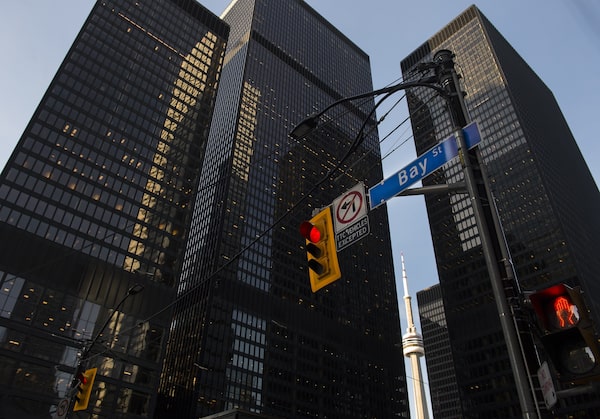
Bay Street in Canada's financial district is shown in Toronto on March 18, 2020.Nathan Denette/The Canadian Press
A new advisory group is calling on Canada’s banking regulator to refrain from raising the capital cushion that the biggest banks must hold, as a deteriorating economy weighs on profits.
In the spring, the Office of the Superintendent of Financial Institutions increased the domestic stability buffer (DSB) – a capital cushion against a potential economic downturn – for the second time in a year, and is scheduled to announce its next decision in December.
The DSB Council, a group of former bank and regulatory executives created by the C.D. Howe Institute last month, said in its first report Wednesday that OSFI should avoid another such increase. The economic “bad times” that the regulator has been warning about have finally arrived, the report says, putting greater pressure on banks already facing squeezed profits and rising expenses.
OSFI raised the buffer in the spring to 3.5 per cent from 3 per cent of a bank’s risk-weighted assets to bolster the “insurance” banks have against mounting risks. When the regulator previously increased the DSB last December, it also raised the buffer’s potential range to between 0 per cent and 4 per cent of a bank’s risk weighted assets.
The regulator raises the DSB in “good times” when the economy is growing. It can choose to lower the buffer in “bad times” of economic stress to free up capital for banks.
In the report, the group acknowledged that vulnerabilities, including rising household and corporate debt, higher borrowing costs and fiscal and monetary policy uncertainty have magnified. But it countered that “economic activity has taken a turn for the worse,” and so “the window has likely closed to raise the DSB buffer further and that doing so could be counterproductive.”
The buffer applies to lenders that are considered systemically important, including the Big Six banks: Royal Bank of Canada, Toronto-Dominion Bank, Bank of Nova Scotia, Bank of Montreal, Canadian Imperial Bank of Commerce and National Bank of Canada.
OSFI Superintendent Peter Routledge said in June that the decision to raise the DSB reflected the elevated risks in the financial system, as climbing interest rates and home prices are boosting household debt levels, making them “more vulnerable to economic shocks.” But he also said that he “will not hesitate” to lower the buffer.
Banking regulators have been signalling growing concern over vulnerabilities in the sector. Last week, the U.S. Federal Reserve said that it is closely monitoring potential losses at banks caused by deteriorating commercial real-estate valuations and elevated interest rates. In October, OSFI warned that higher interest rates and a weakening commercial real-estate market are inflating risks.
But the higher capital requirements also force banks to set aside billions of dollars that would otherwise be earmarked to grow their business, make acquisitions or return money to shareholders through dividend increases and share buybacks.
A DSB adjustment also prompts a change to the minimum capital levels that a bank is expected to hold. The common equity tier 1 (CET1) ratio – a measure of a lender’s ability to absorb losses – climbed to 11.5 per cent from 11 per cent on Nov. 1. Each of the Big Six banks currently exceed the minimum by a wide margin, with all lenders posting a CET1 ratio of more than 12 per cent in the third quarter.
While the banks’ CET1 ratios are expected to exceed 12 per cent in the fourth quarter, “some investors dread another hike in the regulatory minimums set by OSFI,” Bank of Montreal analyst Sohrab Movahedi said in a note to clients on Monday.
“Should OSFI raise the DSB by an additional 50 basis points to the upper limit of 4 per cent, we believe all of the banks are in a position to absorb the higher requirements.” (A basis point is one-hundredth of a percentage point.)
Under the tenure of Mr. Routledge, OSFI has taken a more active role among the country’s largest financial institutions. In recent months, it has also begun outlining how it will probe non-financial threats including foreign interference and national-security – an expanded mandate from the federal government.
“Supervisors need grit. They must have a thick skin in the face of criticism or challenge from the institutions they oversee, just as referees must stand up to players, team owners or spectators,” Deputy Superintendent Ben Gully said in remarks at a C.D. Howe Institute luncheon on Tuesday. He added that, while supervisors must practice healthy skepticism, “they must also ensure that this thick skin does not become a barrier to learning from experience.”
As part of OSFI’s expanded mandate, it is also developing new ways to assess the adequacy of the steps financial institutions take to mitigate risk.
“We don’t expect the new supervisory framework to lead to big surprises in the transition,” Mr. Gully said. “However, regulated institutions may see more rating changes than before as the new framework provides for greater differentiation than the old one.”
No custom component found for subtype: oovvuu-video